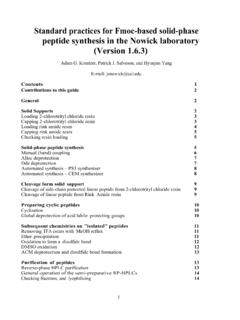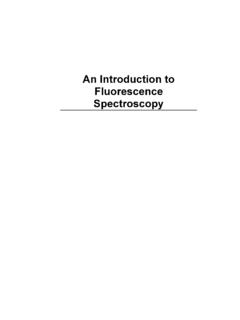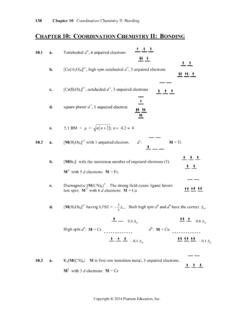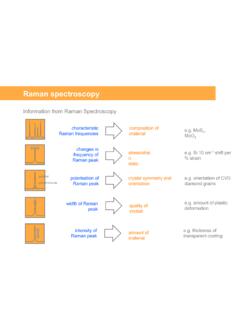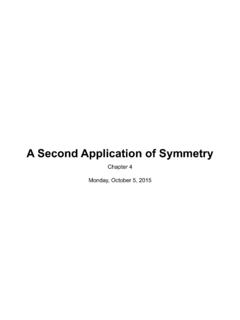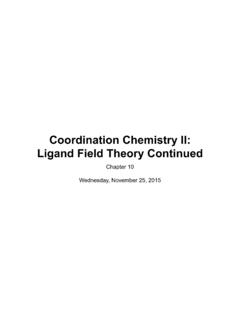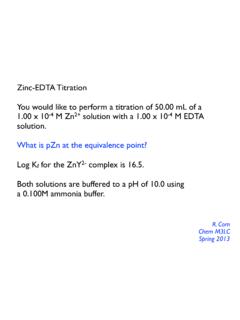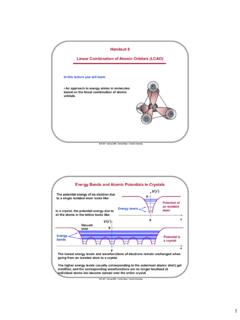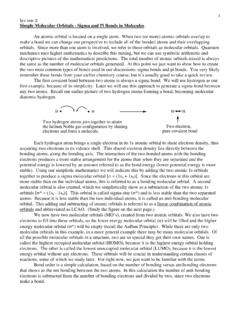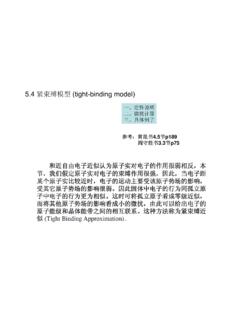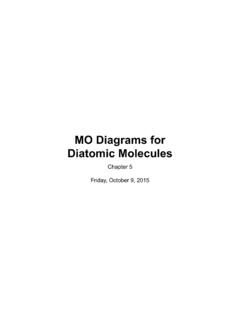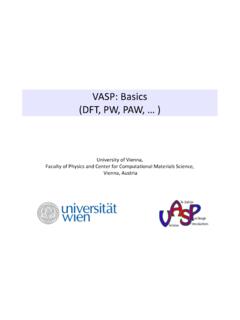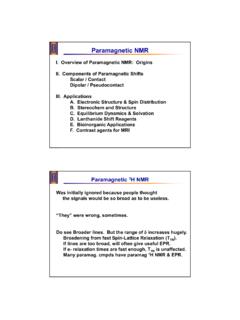Transcription of Simple Molecular Orbital Theory - University of California ...
1 Simple Molecular Orbital Theory Chapter 5 Wednesday, October 7, 2015 Using Symmetry: Molecular OrbitalsOne approach to understanding the electronic structure of molecules is called Molecular Orbital Theory . MO Theory assumes that the valence electrons of the atoms within a molecule become the valence electrons of the entire molecule. Molecular orbitals are constructed by taking linear combinationsof the valence orbitals of atoms within the molecule. For example, consider H2: Symmetry will allow us to treat more complex molecules by helping us to determine which AOs combine to make MOs++1s1sLCAO MO TheoryMO Math for Diatomic Molecules1 A ------ B2 11 22cc Each MO may be written as an LCAO:Since the probability density is given by the square of the wavefunction:probability of finding the electron close to atom Aditto atom Boverlap term, important between the atoms1MO Math for Diatomic MoleculesThe individual AOs are normalized:100% probability of finding electron somewherefor each free atom1 SMO Math for Homonuclear Diatomic MoleculesFor two identical AOs on identical atoms, the electrons are equally shared, so:2212cc 12cc In other words:121/21()[2(1 )]S 121/21()[2(1 )]S ,1 1 2()c ,1 1 2()c So we have two MOs from the two AOs:After normalization (setting and ).
2 Where Sis the overlap integral:11 22cc 01S 21d 21d _LCAO MO Energy Diagram for H2 EnergyH-H E1 E2 E2> E1, so the antibonding Orbital is always more anti-bonding than the bonding Orbital is bondingH2molecule: two 1s atomic orbitals combine to make one bonding and one antibonding Molecular Orbital . HbHaMOs for H2 in phase combination constructive interference large e-density in the internuclear region (bonding) an electron in this MO lowers the molecule s energy out of phase combination destructive interference small e-density in the internuclear region (antibonding) nodal plane between atoms an electron in this MO raises the molecule s energy22212 121(2)2(1 )S 22212 121(2)2(1 )S MO Notation Schematic representations of the MOs: shading indicates sign of AO size of AO reflects the magnitude of its coefficient in the MOBasic Rule #1 of MO TheoryRule #1: The interaction of nAOs leads to the formation of nMOs.
3 If n= 2, one MO is bonding and one antibonding. The bonding Orbital is more stable than the lower-energy AO. The antibonding Orbital is less stable than the higher-energy AO. The bonding Orbital is stabilized less than the antibonding Orbital is destabilized. 1 2 EE H2vs. He2dihydrogenbond order: 1stable moleculebond order: 0unstable moleculediheliumBO 12# bonding e # anti-bonding e Basic Rule #2 of MO TheoryRule #2: If the AOs are degenerate, their interaction is proportional to their overlap integral, S. 1 2 1 2 large overlapsmall overlapThe greater the degree of overlap, the stronger the Rule #3 of MO TheoryIf the overlap integral between two orbitals centered on different atoms is zero, then there is no interaction between them. If an Orbital has S= 0 with all other orbitals in the molecule, then it is a 100% non-bonding Orbital . S= 0 if orbitals have different irreducible representations.
4 If S 0, then bonding and antibonding MOs #3: Orbitals must have the same symmetry (same irreducible representation) to have non-zero overlap. Overlap and Bond TypeOverlap and Symmetry1s/1ssigma parallel 2p/2ppiSSThe extent of overlap depends on the internuclear separation, the nature of the orbitals involved (s, p, or d), and their relative orientation. perpendicular 2p/2p have zero overlap by symmetryS= 0S= 0 Overlap and SymmetryS1s/2p1s/2p overlap depends on the angle : overlap goes as cos : = 90 S= 0 = 0 Overlap and Symmetrydorbitalssigmapideltazero overlap by symmetryBasic Rule #4 of MO TheoryRule #4: If the AOs are non-degenerate, their interaction is proportional to S2/ E, where E is the energy separation between the AOs. In this case the bonding Orbital is mostly localized on the atom with the deeper lying AO, usually the more electronegative atom. The antibonding Orbital is mostly localized on the atom with the higher AO.
5 1 2 2212cc 11 22cc Orbitals with E > 12-14 eV have essentially zero Rule #4 of MO Theorystrong interactionbonding and antibonding weak interactionalmost nonbonding
